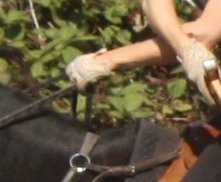Up till now all discussing of the Riding 1 curriculum has implied the use of two hands on the reins. This is because we ride with English tack in the Cavaliere program and teach English style riding (for the reasons for this see these previous posts: English or Western pt I and pt II). However, it's fairly obvious that at some point in your training you'll need to put both reins in one hand to pick up a sword or lance. Because we want you to feel comfortable with this as soon as possible, the level one test includes:
10. Demonstrate single hand (overhand) reining at walk and trot
and
11. Transitions (halt, walk, trot) with overhand reining
Rather than use Western neck reining (which not all of our horses understand) we bridge the reins. The simplest way to do this is to turn both hands palm down, place one hand over the other and cross the reins in the palm of one hand.
If you are right handed you would use your left hand for the reins, and your right for your sword. The left rein enters your hand from the pinkie side, and the right rein from the thumb side. I tend to leave the little finger free and use my ring and forefingers to control the reins, but that's a matter of personal preference.
To signal a right turn, curve your wrist with the thumb towards your body, shortening the right rein, and bring the hand slightly to the right. For a left turn curl the outside (little finger) of your hand towards yourself and bring your hand slightly to the left.
In all these pictures the rider is asking for a slight left bend using different wrist positions according to the pace and degree of bend. Different horses will require different degrees of cue, so your technique will need to adapt according to the horse you are riding.
Overhand reining requires a shorter rein than regular reining. For optimum control your hand should be low to the crest and about one quarter to one third the way up the neck, with less bend in the elbow than you would have in a classic direct rein position.
Practice switching from one hand to two, and alternate hands, regardless of the hand in which you normally carry your sword. Single hand reining has many applications outside of mounted combat, including mounted games, opening gates on the trail, and ponying (leading) a spare horse. It's worth your while to get good at it!
Cavaliere Classes
The weather was kind to us for the first of our new-format Cavaliere classes on the weekend: the rain stopped before our first riders were mounted, and then came pelting down just as we put our swords away. Doing sword drills after riding proved a great way to stretch out, warm up, and loosen up while keeping our quandrant defences fresh in the mind.
Open Barn
Open Barn is back! This is an opportunity to come out to Red Colt and work independently on your riding, horsemanship or swordsmanship. Participants must have a minimum of Riding 1, or be pre-approved, in order to ride. Cost for riding a borrowed horse is $10; no cost for sword or grooming practice. Open Barn generally takes place on the 3rd Sunday of the month.
